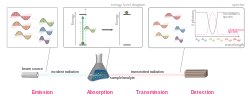Fil:Spectroscopy overview.svg

Opprinnelig fil (SVG-fil, standardstørrelse 760 × 303 piksler, filstørrelse: 2,49 MB)
Denne filen er fra Wikimedia Commons og kan brukes av andre prosjekter. Beskrivelsen fra filbeskrivelsessida vises nedenfor.
Beskrivelse
| BeskrivelseSpectroscopy overview.svg |
Català: Esquema de l'absorció de radiació electromagnètica.
English: An overview of electromagnetic radiation absorption. This example discusses the general principle using visible light as specific example. A white beam source -- emitting light of multiple wavelengths -- is focused on a sample (the complementary color pairs are indicated by the yellow dotted lines. Upon striking the sample, photons that match the energy gap of the molecules present (green light in this example) are absorbed in order to excite the molecule. Other photons transmit unaffected and, if the radiation is in the visible region (400-700nm), the transmitted light appears as its complementary color. By comparing the attenuation of the transmitted light with the incident, an absorption spectrum can be obtained. |
| Dato | |
| Kilde | Eget verk |
| Opphavsperson | Jon Chui |
| Andre versjoner |
Derivative works of this file: File:Spectroscopy overview.svg has 3 translations.
Other related versions: [rediger]
|
This file is translated using SVG For most Wikipedia projects, you can embed the file normally (without a To translate the text into your language, you can use the SVG Translate tool. Alternatively, you can download the file to your computer, add your translations using whatever software you're familiar with, and re-upload it with the same name. You will find help in Graphics Lab if you're not sure how to do this. |
Denne SVG-fila inneholder tekst som enkelt kan oversettes til andre språk. Lær mer. For SVG-bilder kan du benytte [toolforge:svgtranslate/File:Spectroscopy_overview.svglink denne sida] for å oversette teksten til et annet språk. |
Lisensiering
- Du står fritt:
- til å dele – til å kopiere, distribuere og overføre verket
- til å blande – til å endre verket
- Under de følgende betingelsene:
- navngivelse – Du må kreditere verket på passende vis, lenke til lisensen og indikere hvorvidt det har blitt gjort endringer. Du kan gjøre det på enhver rimelig måte, men ikke på en måte som antyder at lisensgiveren støtter deg eller din bruk av verket.
- del på samme vilkår – Dersom du remikser, omarbeider eller på annen måte bygger på dette verket, må du kun distribuere resultatet under den samme eller en samsvarende lisens som denne.

|
Det tillates at dette dokumentet kopieres, distribueres og/eller modifiseres under retningslinjene som beskrevet i GNU fri dokumentasjonslisens, versjon 1.2 eller senere utgave utgitt av Free Software Foundation; med alle seksjoner, uten noen forsidetekster og baksidetekster. En kopi av lisensen er inkludert i avsnittet GNU Free Documentation License.http://www.gnu.org/copyleft/fdl.htmlGFDLGNU Free Documentation Licensetruetrue |
| Annotations InfoField | This image is annotated: View the annotations at Commons |
White light is composed of continuous wavelengths of light in the visible region (400-700nm). Here we simplify its representation with discrete colors arranged in descending order wavelength (i.e., increasing energy). Polarization does not affect absorption and is not represented; complementary colors are denoted with yellow dotted lines.
"Beam source" generally indicates a broad spectrum light, e.g., from black-body radiation. Lasers are not within this scope as they are monochromatic (single wavelength).
Molecules have quantized energy levels, and photons have quantized energy. If the incoming photon has exactly the matching energy for the promotion of the molecule, the molecule would absorb the photon, and change state from the ground state to an excited state. The specific physical change depends on the radiation.
Light in the visible region induces electronic excitation (rearrangement of electron clouds).
This applies only for visible light - the removal of a color results in the beam appearing as its complementary color. Here, the removal of green within the red-green pair gives the transmitted beam a red color.
Note that absorptions always has a non-zero line-width despite the quantized nature of light and matter. This is discussed in the article on line broadening.
A spectrum is effectively a (continuous) histogram describing the composition of light. A spectrum can be represented as a transmission spectrum (shown in gray) where the y-axis shows the photon count of transmitted light, or an absorption spectrum (magenta) where the attenuation is plotted. The former is commonly used in infrared/microwave spectroscopy, and the latter in UV-Vis and NMR.
Historically a detector is an optical device where the beam is split (by a diffraction grating or prism) and captured on a photographic plate. Modern spectroscopy usually uses a CCD array in conjunction with digital electronics.
In the laboratory, this is commonly a sample containing an analyte dissolved in a solvent. Spectroscopy is a general technique - an example on the astronomical scale would involve a star as the "beam source", a planet as the "sample", and a telescope-CCD array as the detector, with interstellar space between each. The concepts and principles remain the same.
Despite the quantized nature of light and matter, absorptions are broad and never of zero line-width. This phenomenon is explained in the article on line broadening.

|
This image has been assessed under the valued image criteria and is considered the most valued image on Commons within the scope: Overview of Absorption Spectroscopy. You can see its nomination here. |
Bildetekster
Elementer som er med i denne fila
motiv
En verdi uten element på Wikidata
8. jan. 2011
image/svg+xml
Filhistorikk
Klikk på et tidspunkt for å vise filen slik den var på det tidspunktet.
| Dato/klokkeslett | Miniatyrbilde | Dimensjoner | Bruker | Kommentar | |
|---|---|---|---|---|---|
| nåværende | 30. sep. 2023 kl. 13:20 | 760 × 303 (2,49 MB) | wikimediacommons>Townie | File uploaded using svgtranslate tool (https://svgtranslate.toolforge.org/). Added translation for ca. |
Filbruk
Den følgende siden bruker denne filen:
Metadata
Denne filen inneholder tilleggsinformasjon, sannsynligvis lagt til av digitalkameraet eller skanneren som ble brukt til å lage eller digitalisere det.
Hvis filen har blitt forandret fra utgangspunktet, kan enkelte detaljer være unøyaktige.
| Bredde | 760.243px |
|---|---|
| Høyde | 302.655px |


